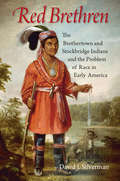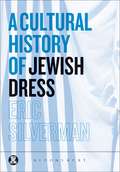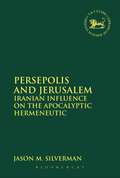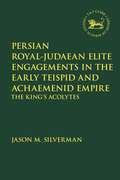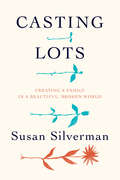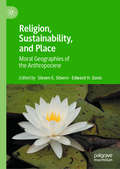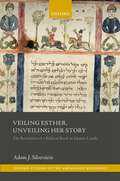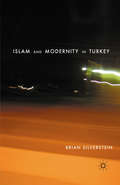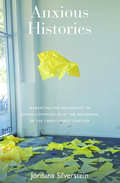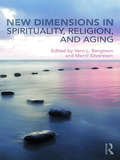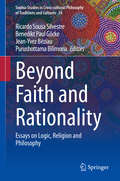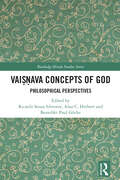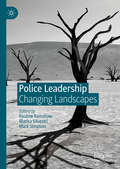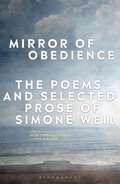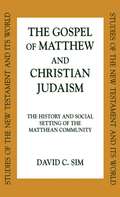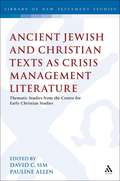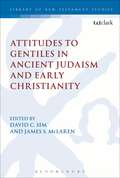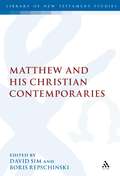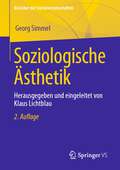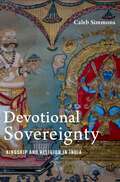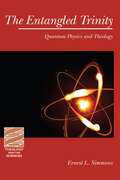- Table View
- List View
Red Brethren: The Brothertown and Stockbridge Indians and the Problem of Race in Early America
by David J. SilvermanNew England Indians created the multitribal Brothertown and Stockbridge communities during the eighteenth century with the intent of using Christianity and civilized reforms to cope with white expansion. In Red Brethren, David J. Silverman considers the stories of these communities and argues that Indians in early America were racial thinkers in their own right and that indigenous people rallied together as Indians not only in the context of violent resistance but also in campaigns to adjust peacefully to white dominion. All too often, the Indians discovered that their many concessions to white demands earned them no relief. In the era of the American Revolution, the pressure of white settlements forced the Brothertowns and Stockbridges from New England to Oneida country in upstate New York. During the early nineteenth century, whites forced these Indians from Oneida country, too, until they finally wound up in Wisconsin. Tired of moving, in the 1830s and 1840s, the Brothertowns and Stockbridges became some of the first Indians to accept U.S. citizenship, which they called "becoming white," in the hope that this status would enable them to remain as Indians in Wisconsin. Even then, whites would not leave them alone.Red Brethren traces the evolution of Indian ideas about race under this relentless pressure. In the early seventeenth century, indigenous people did not conceive of themselves as Indian. They sharpened their sense of Indian identity as they realized that Christianity would not bridge their many differences with whites, and as they fought to keep blacks out of their communities. The stories of Brothertown and Stockbridge shed light on the dynamism of Indians' own racial history and the place of Indians in the racial history of early America.
A Cultural History of Jewish Dress (Dress, Body, Culture)
by Eric SilvermanA Cultural History of Jewish Dress is the first comprehensive account of how Jews have been distinguished by their appearance from Ancient Israel to the present. For centuries Jews have dressed in distinctive ways to communicate their devotion to God, their religious identity, and the proper earthly roles of men and women. This lively work explores the rich history of Jewish dress, examining how Jews and non-Jews alike debated and legislated Jewish attire in different places, as well as outlining the big debates on dress within the Jewish community today.Focusing on tensions over gender, ethnic identity and assimilation, each chapter discusses the meaning and symbolism of a specific era or type of Jewish dress. What were biblical and rabbinic fashions? Why was clothing so important to immigrant Jews in America? Why do Hassidic Jews wear black? When did yarmulkes become bar mitzvah souvenirs? The book also offers the first analysis of how young Jewish adults today announce on caps, shirts, and even undergarments their striving to transform Jewishness from a religious and historical heritage into an ethnic identity that is hip, racy, and irreverent. Fascinating and accessibly written, A Cultural History of Jewish Dress will appeal to anybody interested in the central role of clothing in defining Jewish identity.
A Cultural History of Jewish Dress (Dress, Body, Culture)
by Eric SilvermanA Cultural History of Jewish Dress is the first comprehensive account of how Jews have been distinguished by their appearance from Ancient Israel to the present. For centuries Jews have dressed in distinctive ways to communicate their devotion to God, their religious identity, and the proper earthly roles of men and women. This lively work explores the rich history of Jewish dress, examining how Jews and non-Jews alike debated and legislated Jewish attire in different places, as well as outlining the big debates on dress within the Jewish community today.Focusing on tensions over gender, ethnic identity and assimilation, each chapter discusses the meaning and symbolism of a specific era or type of Jewish dress. What were biblical and rabbinic fashions? Why was clothing so important to immigrant Jews in America? Why do Hassidic Jews wear black? When did yarmulkes become bar mitzvah souvenirs? The book also offers the first analysis of how young Jewish adults today announce on caps, shirts, and even undergarments their striving to transform Jewishness from a religious and historical heritage into an ethnic identity that is hip, racy, and irreverent. Fascinating and accessibly written, A Cultural History of Jewish Dress will appeal to anybody interested in the central role of clothing in defining Jewish identity.
Persepolis and Jerusalem: Iranian Influence on the Apocalyptic Hermeneutic (The\library Of Hebrew Bible/old Testament Studies)
by Jason M. SilvermanPersepolis and Jerusalem reconsiders Iranian influence upon Jewish apocalyptic, and offers grounds upon which such study may proceed. After describing the history of scholarship on the question of Iranian influence and on Jewish apocalyptic, Jason M. Silverman reformulates the methodology for understanding apocalyptic and influence. Two chapters set the discussion firmly in the Achaemenid Empire, describing the sources for Iranian religion, the issues involved in attempting a historical reconstruction, the methodology by which one can date the various texts and ideas, and the potential loci for Iranian-Judaean interaction. The historical context is expanded through media-contextualization, particularly Oral Theory, and critiques the standard text-centric method of current Biblical Scholarship. With this background, pericopes from Ezekiel, Daniel, and 1 Enoch are analyzed for Iranian influence. The study then brings together the contexts and analyses to argue for an 'Apocalyptic Hermeneutic' which relates the phenomena of apocalypticism, apocalypse, and millenarianism-seeing the hermeneutic as a dialectical thread holding them all together as well as apart- and posits this as the best place to understand Iranian influences.
Persian Royal–Judaean Elite Engagements in the Early Teispid and Achaemenid Empire: The King's Acolytes (The Library of Hebrew Bible/Old Testament Studies)
by Jason M. SilvermanJason Silverman presents a timely and necessary study, advancing the understanding of Achaemenid ideology and Persian Period Judaism. While the Achaemenid Persian Empire (c. 550–330 BCE) dwarfed all previous empires of the Ancient Near East in both size and longevity, the royal system that forged and preserved this civilisation remains only rudimentarily understood, as is the imperial and religious legacy bequeathed to future generations. In response to this deficit, Silverman provides a critically sophisticated and interdisciplinary model for comparative studies. While the Achaemenids rebuilt the Jerusalem temple, Judaean literature of the period reflects tensions over its Persian re-establishment, demonstrating colliding religious perspectives. Although both First Zechariah (1–8) and Second Isaiah (40–55) are controversial, the greater imperial context is rarely dealt with in depth; both books deal directly with the temple's legitimacy, and this ties them intimately to kings' engagements with cults. Silverman explores how the Achaemenid kings portrayed their rule to subject minorities, the ways in which minority elites reshaped this ideology, and how long this impact lasted, as revealed through the Judaean reactions to the restoration of the Jerusalem temple.
Casting Lots: Creating a Family in a Beautiful, Broken World
by Susan SilvermanSusan Silverman grew up with parents who were, both before and after a devastating loss, atheists. Yet, as a young adult, she shocked everyone who knew her ("But you were elected Class Flirt in high school!") and became a rabbi. What was not surprising, however, was that she built her own big, unwieldy family through both birth and adoption, something she had intended from childhood. With three daughters and two sons ("We produce girls and import boys"), this unique family becomes a metaphor for the world's contradictions and complexities-a microcosm of the tragedy and joy, hope and despair, cruelty and compassion, predictability and absurdity of this world we all live in. A meditation on identity, faith, and belonging-one that's as funny as it is moving-Casting Lots will resonate with anyone who has struggled to find their place in the world and to understand the significance of that place.
Casting Lots: Creating a Family in a Beautiful, Broken World
by Susan SilvermanSusan Silverman grew up with parents who were, both before and after a devastating loss, atheists. Yet, as a young adult, she shocked everyone who knew her ("But you were elected Class Flirt in high school!") and became a rabbi. What was not surprising, however, was that she built her own big, unwieldy family through both birth and adoption, something she had intended from childhood. With three daughters and two sons ("We produce girls and import boys"), this unique family becomes a metaphor for the world's contradictions and complexities-a microcosm of the tragedy and joy, hope and despair, cruelty and compassion, predictability and absurdity of this world we all live in. A meditation on identity, faith, and belonging-one that's as funny as it is moving-Casting Lots will resonate with anyone who has struggled to find their place in the world and to understand the significance of that place.
Religion, Sustainability, and Place: Moral Geographies of the Anthropocene
by Steven E. Silvern Edward H. DavisThis book explores how religious groups work to create sustainable relationships between people, places and environments. This interdisciplinary volume deepens our understanding of this relationship, revealing that the geographical imagination—our sense of place—is a key aspect of the sustainability ideas and practices of religious groups. The book begins with a broad examination of how place shapes faith-based ideas about sustainability, with examples drawn from indigenous Hawaiians and the sacred texts of Judaism and Islam. Empirical case studies from North America, Europe, Central Asia and Africa follow, illustrating how a local, bounded, and sacred sense of place informs religious-based efforts to protect people and natural resources from threatening economic and political forces. Other contributors demonstrate that a cosmopolitan geographical imagination, viewing place as extending from the local to the global, shapes the struggles of Christian, Jewish and interfaith groups to promote just and sustainable food systems and battle the climate crisis.
Veiling Esther, Unveiling Her Story: The Reception of a Biblical Book in Islamic Lands (Oxford Studies in the Abrahamic Religions)
by Adam J. SilversteinVeiling Esther, Unveiling Her Story: The Reception of a Biblical Book in Islamic Lands examines the ways in which the Biblical Book of Esther was read, understood, and used in Muslim lands, from ancient to modern times. It focuses on case studies covering works from various periods and regions of the Muslim world, including the Qur'an, pre-modern historical chronicles and literary works, the writings of a nineteenth-century Shia feminist, a twentieth-century Iranian encyclopaedia, and others. These case studies demonstrate that Muslim sources contain valuable materials on Esther, which shed light both on the Esther story itself and on the Muslim peoples and cultures that received it. Adam J. Silverstein argues that Muslim sources preserve important pre-Islamic materials on Esther that have not survived elsewhere, some of which offer answers to ancient questions about Esther, such as the meaning of Haman's epithet in the Greek versions of the story, the reason why Mordecai refused to prostrate before Haman, and the literary context of the 'plot of the eunuchs' to kill the Persian king. Throughout the book, Silverstein shows how each author's cultural and religious background influenced his or her understanding and retelling of the Esther story. In particular, he highlights that Persian Muslims (and Jews) were often forced to reconcile or choose between the conflicting historical narratives provided by their religious and cultural heritages respectively.
Veiling Esther, Unveiling Her Story: The Reception of a Biblical Book in Islamic Lands (Oxford Studies in the Abrahamic Religions)
by Adam J. SilversteinVeiling Esther, Unveiling Her Story: The Reception of a Biblical Book in Islamic Lands examines the ways in which the Biblical Book of Esther was read, understood, and used in Muslim lands, from ancient to modern times. It focuses on case studies covering works from various periods and regions of the Muslim world, including the Qur'an, pre-modern historical chronicles and literary works, the writings of a nineteenth-century Shia feminist, a twentieth-century Iranian encyclopaedia, and others. These case studies demonstrate that Muslim sources contain valuable materials on Esther, which shed light both on the Esther story itself and on the Muslim peoples and cultures that received it. Adam J. Silverstein argues that Muslim sources preserve important pre-Islamic materials on Esther that have not survived elsewhere, some of which offer answers to ancient questions about Esther, such as the meaning of Haman's epithet in the Greek versions of the story, the reason why Mordecai refused to prostrate before Haman, and the literary context of the 'plot of the eunuchs' to kill the Persian king. Throughout the book, Silverstein shows how each author's cultural and religious background influenced his or her understanding and retelling of the Esther story. In particular, he highlights that Persian Muslims (and Jews) were often forced to reconcile or choose between the conflicting historical narratives provided by their religious and cultural heritages respectively.
Islam and Modernity in Turkey
by B. SilversteinIn contrast to much of the Muslim world, a majority of Turks consider Islam to be primarily a matter of personal choice and private belief. How did such an arrangement come about? Moreover, most observant Muslims in Turkey do not see such a conception and practice of Islam as illegitimate. Why not? Islam and Modernity in Turkey addresses these questions through an ethnographic study of Islamic discourses and practices and their articulation with mass media in Turkey, against the background of late Ottoman and early Republican precedents. This ground-breaking book sheds new light on issues of commensurability and difference in culture, religion, and history, and reformulates our understanding of Islam, secularism, and public life in Turkey, the Muslim world, and Europe.
Anxious Histories: Narrating the Holocaust in Jewish Communities at the Beginning of the Twenty-First Century
by Jordana SilversteinOver the last seventy years, memories and narratives of the Holocaust have played a significant role in constructing Jewish communities. The author explores one field where these narratives are disseminated: Holocaust pedagogy in Jewish schools in Melbourne and New York. Bringing together a diverse range of critical approaches, including memory studies, gender studies, diaspora theory, and settler colonial studies, Anxious Histories complicates the stories being told about the Holocaust in these Jewish schools and their broader communities. It demonstrates that an anxious thread runs throughout these historical narratives, as the pedagogy negotiates feelings of simultaneous belonging and not-belonging in the West and in Zionism. In locating that anxiety, the possibilities and the limitations of narrating histories of the Holocaust are opened up once again for analysis, critique, discussion, and development.
New Dimensions in Spirituality, Religion, and Aging: Neglected Aspects Of Human Development
by Merril Silverstein Vern L BengtsonNew Dimensions in Spirituality, Religion, and Aging expands the traditional focus of religiosity to include and evaluate recent research and discoveries on the role of secular spirituality in the aging process. Contributors examine the ways conventional religion and other forms of spirituality affect human development, health and longevity, and they demonstrate how myth-creation enables humans to make meaning in their lives. Taken together, the book points to further research to enhance current knowledge, approaches to care, and social policies.
Beyond Faith and Rationality: Essays on Logic, Religion and Philosophy (Sophia Studies in Cross-cultural Philosophy of Traditions and Cultures #34)
by Ricardo Sousa Silvestre Benedikt Paul Göcke Jean-Yvez Béziau Purushottama BilimoriaThis volume deals with the relation between faith and reason, and brings the latest developments of modern logic into the scene. Faith and rationality are two perennial key concepts in the history of ideas. Philosophers and theologians have struggled to bring into harmony these otherwise conflicting concepts. Despite the diversity of approaches about what rationality effectively means, logic remains the cannon of objective and rational thought. The chapters in this volume analyze several issues pertaining to the philosophy of religion and philosophical theology from the perspective of their relation to logic and the benefit they can derive from the use of modern logic tools. The book is divided into five parts: (I) Introduction, (II) Analytic Philosophy of Religion, (III) Logical Philosophy of Religion, (IV) Computational Philosophy and Religion and (V) Logic, Language and Religion. This text appeals to students and researchers in the field.
Vaiṣṇava Concepts of God: Philosophical Perspectives (Routledge Hindu Studies Series)
by Ricardo Sousa Silvestre Alan C. Herbert Benedikt Paul GöckeThis book explores a number of concepts of God in Vaiṣṇavism, which is commonly referred to as one of the great Hindu monotheistic traditions. By addressing the question of what attributes God possesses according to particular Vaiṣṇava textual sources and traditions, the book locates these concepts within a global philosophical framework. The book is divided into two parts. The first part, God in Vaiṣṇava Texts, deals with concepts of God found in some of the more prominent canonical Vaiṣṇava texts: the Bhagavad-Gītā, the Bhagavata-Purāṇa, the Jayākhya-Saṃhitā as representative of the Pāñcarātras, and the Mahābhārata. The second part, God in Vaiṣṇava Traditions, addresses concepts of God found in several Vaiṣṇava traditions and their respective key theologians. In addition to the Āḻvārs, the five traditional Vaiṣṇava schools—the Śrī Vaiṣṇava tradition, the Madhva tradition, the Nimbārka tradition, the Puṣṭimārga tradition, and the Caitanya Vaiṣṇava tradition—and two contemporary ones—those of Ramakrishna (who has Vaiṣṇava leanings) and Swami Bhaktivedanta—are considered. The book combines normative, critical, and descriptive elements. Some chapters are philosophical in nature, and others are more descriptive. Each unpacks a specific Vaiṣṇava concept of God for future philosophical analysis and critique. Written by experts who break new ground in this presentation and representation of the diversity of Vaiṣṇava texts and traditions, the book provides approaches that reflect the amount of philosophical and historical deliberation on the specific issues and divine attributes so far considered in the field of Hindu Studies. This book will be of interest to researchers in disciplines including philosophy of religion and Indian philosophy, cross-cultural and comparative philosophy, analytic philosophy of religion, Hindu Studies, theology, and religious studies.
Police Leadership: Changing Landscapes
by Marisa Silvestri Mark Simpson Pauline RamshawThis book draws upon a range of theoretical and empirical research to explore contemporary debates about police leadership. Focusing upon leadership styles, ethics, integrity and professionalism, workforce diversity, legitimacy and accountability, it reviews the changing context and nature of leadership over time and explores the gains, losses, tensions and challenges that different leadership models bring to policing. Leadership is present at various levels within the police service and this collection reflects upon appropriate leadership qualities and requirements for different roles and at different ranks. The book also considers the difference between leadership and management in an attempt to capture fuller debates within police leadership. Part one surmises the contextual backdrop to current thinking and the primary challenges facing leadership in the police service. Part two highlights the changing face of leadership through an exploration of the call for greater diversity within the ranks of police leadership, and the final section examines police leadership beyond England and Wales. Through this, Police Leadership explores how the challenges facing police leadership in England and Wales share similarities with those in Scotland, Northern Ireland, Greece, North America, and Australia in the face of the pressures of political and economic uncertainty.
Mirror of Obedience: The Poems and Selected Prose of Simone Weil
by Silvia Caprioglio Panizza and Philip WilsonSimone Weil (1909-1943) was one of the foremost French philosophers of the 20th century; a mystic, activist, and writer whose profound work continues to intrigue and inspire today. Mirror of Obedience collects together Weil's poetry and autobiographical writings translated into English for the first time. It offers a rare glimpse into a more personal and introspective Weil than we usually encounter. She was writing and re-working her poems until the end of her life and in a letter from London to her parents, dated 22 January 1943, she expressed the wish for her verses to appear together in print in chronological order, a wish which this volume honours.Weil was a thinker who wrote with discipline and spareness and cherished the poetic form for its power to compress language and distill meaning. In these poems and literary writings, we see her own efforts to craft poems as essential expressions of thought, bringing into view another aspect of Weil's quest for beauty and truth.
The Gospel of Matthew and Christian Judaism: The History and Social Setting of the Matthean Community (Studies of the New Testament and Its World)
by David C. SimIn this meticulously researched and compelling study, David Sim reconstructs the social setting of the Matthean community at the time the Gospel was written and traces its full history.Dr Sim argues that the Matthean community should be located in Antioch towards the latter part of the first century. He acknowledges the dispute within the early Christian movement and its importance. He defines more accurately the distinctive perspectives of the two streams of thought and their respective relationships to Judaism. A new and important work in Matthean studies.
Ancient Jewish and Christian Texts as Crisis Management Literature: Thematic Studies from the Centre for Early Christian Studies (The Library of New Testament Studies #445)
by David C. Sim Pauline AllenThis volume seeks to demonstrate, for the first time, that many Jewish and Christian texts in the ancient world were written as a direct response to an earlier situation of crisis that affected the author, or the intended reader. Presented here are texts from both traditions that were written over many centuries in order to establish that such crisis management literature was widespread in the religious and theological literature of ancient times. These chosen works reveal that all manner of crises could contribute to the production or the nature of these texts; including persecution, political factors, religious or theological differences, social circumstances; as well as internal or external threats. By understanding this crucial element in the composition of these texts we are better able to understand the complexity of social, political and religious forces that gave rise to many ancient theological texts, and to appreciate the strategies which the authors used to manage these crises.
Attitudes to Gentiles in Ancient Judaism and Early Christianity (The Library of New Testament Studies #499)
by David C. Sim James S. McLarenThis volume describes the attitudes towards Gentiles in both ancient Judaism and the early Christian tradition. The Jewish relationship with and views about the Gentiles played an important part in Jewish self-definition, especially in the Diaspora where Jews formed the minority among larger Gentile populations. Jewish attitudes towards the Gentiles can be found in the writings of prominent Jewish authors (Josephus and Philo), sectarian movements and texts (the Qumran community, apocalyptic literature, Jesus) and in Jewish institutions such as the Jerusalem Temple and the synagogue. In the Christian tradition, which began as a Jewish movement but developed quickly into a predominantly Gentile tradition, the role and status of Gentile believers in Jesus was always of crucial significance. Did Gentile believers need to convert to Judaism as an essential component of their affiliation with Jesus, or had the appearance of the messiah rendered such distinctions invalid? This volume assesses the wide variety of viewpoints in terms of attitudes towards Gentiles and the status and expectations of Gentiles in the Christian church.
Matthew and his Christian Contemporaries (The Library of New Testament Studies #333)
by David C. Sim Boris RepschinskiThis volume aims to compare the author of Matthew's Gospel with a selection of contemporary Christian authors and/or texts. Recent Matthean scholarship has highlighted the distinctiveness of this early Christian writer by emphasising his clear Jewish perspective in addition to his Christian affiliation. He can accurately be perceived as both Jewish and Christian because he holds that Christian commitment demands both observance of the Mosaic Law and faith in Jesus as the Messiah. But if Matthew is distinctively Jewish and Christian, how does he compare with other early Christian writers? Much of the New Testament literature was composed by Paul himself or by his later followers, and these Christians held the view that the Mosaic Law no longer had relevance in the light of the Christ event. Other New Testament texts that are not Pauline, e.g. the Gospel of John and the letter to the Hebrews, appear to agree with Paul on this point. Consequently, Matthew stands apart from other texts in the canon with the possible exception of the letter of James. The volume will therefore establish the distinctiveness of Matthew by comparing his theological perspective with his major sources, Mark and Q, and with the two remaining Gospels, the Pauline epistles, the letter to the Hebrews and the epistle of James. The comparison of Matthew with non-canonical texts, the Didache and the letters of Ignatius of Antioch, is important because much work has been done in these areas recently. Given Matthew's distinctive portrayal of Jesus, a comparison of Matthew and the historical Jesus is also demanded in the context of this volume.
Soziologische Ästhetik: Herausgegeben und eingeleitet von Klaus Lichtblau (Klassiker der Sozialwissenschaften)
by Georg SimmelGeorg Simmel gilt zu Recht als ein klassischer Theoretiker der Moderne. Er sah im Überschneidungsbereich von ästhetischer Erfahrung und einer genuin soziologischen Beschreibung von Modernität die Möglichkeit gegeben, der epochalen Eigenart des modernen Lebens mit all seinen Spannungen, Konflikten und Paradoxien auf die Spur zu kommen, ohne diese vorschnell unter eine begriffliche Systematik zu subsumieren. In diesem Band wird Simmels Programm einer „soziologischen Ästhetik“ unter anderem anhand einiger seiner kunstkritischen Schriften aus den 1890er Jahren, seiner Arbeiten über die Rolle der modernen Kunst- und Gewerbeausstellungen, der Mode und dem Schmuck sowie seiner luziden Studien über die Geselligkeit und die Koketterie dokumentiert.
Devotional Sovereignty: Kingship and Religion in India (AAR Religion Culture and History)
by Caleb SimmonsDevotional Sovereignty: Kingship and Religion in India investigates the shifting conceptualization of sovereignty in the South Indian kingdom of Mysore during the reigns of Tipu Sultan (r. 1782-1799) and Krishnaraja Wodeyar III (r. 1799-1868). Tipu Sultan was a Muslim king famous for resisting British dominance until his death; Krishnaraja III was a Hindu king who succumbed to British political and administrative control. Despite their differences, the courts of both kings dealt with the changing political landscape by turning to the religious and mythical past to construct a royal identity for their kings. Caleb Simmons explores the ways in which these two kings and their courts modified and adapted pre-modern Indian notions of sovereignty and kingship in reaction to British intervention. The religious past provided an idiom through which the Mysore courts could articulate their rulers' claims to kingship in the region, attributing their rule to divine election and employing religious vocabulary in a variety of courtly genres and media. Through critical inquiry into the transitional early colonial period, this study sheds new light on pre-modern and modern India, with implications for our understanding of contemporary politics. It offers a revisionist history of the accepted narrative in which Tipu Sultan is viewed as a radical Muslim reformer and Krishnaraja III as a powerless British puppet. Simmons paints a picture of both rulers in which they work within and from the same understanding of kingship, utilizing devotion to Hindu gods, goddesses, and gurus to perform the duties of the king.
Devotional Sovereignty: Kingship and Religion in India (AAR Religion Culture and History)
by Caleb SimmonsDevotional Sovereignty: Kingship and Religion in India investigates the shifting conceptualization of sovereignty in the South Indian kingdom of Mysore during the reigns of Tipu Sultan (r. 1782-1799) and Krishnaraja Wodeyar III (r. 1799-1868). Tipu Sultan was a Muslim king famous for resisting British dominance until his death; Krishnaraja III was a Hindu king who succumbed to British political and administrative control. Despite their differences, the courts of both kings dealt with the changing political landscape by turning to the religious and mythical past to construct a royal identity for their kings. Caleb Simmons explores the ways in which these two kings and their courts modified and adapted pre-modern Indian notions of sovereignty and kingship in reaction to British intervention. The religious past provided an idiom through which the Mysore courts could articulate their rulers' claims to kingship in the region, attributing their rule to divine election and employing religious vocabulary in a variety of courtly genres and media. Through critical inquiry into the transitional early colonial period, this study sheds new light on pre-modern and modern India, with implications for our understanding of contemporary politics. It offers a revisionist history of the accepted narrative in which Tipu Sultan is viewed as a radical Muslim reformer and Krishnaraja III as a powerless British puppet. Simmons paints a picture of both rulers in which they work within and from the same understanding of kingship, utilizing devotion to Hindu gods, goddesses, and gurus to perform the duties of the king.
The Entangled Trinity: Quantum Physics And Theology (Theology And The Sciences Ser.)
by Ernest L. SimmonsThe Doctrine of the Trinity is an exercise in wonder. It is drawn from the wonder of our own existence and the diverse experiences of the divine encountered by the early Christian community. From the earliest days of Christianity, theologians of the church have drawn upon the most sophisticated language and understandings of their time in an attempt to clarify and express that faith and this task is no different today. But how should we attempt to articulate that faith today? In this volume, Ernest Simmons engages precisely that question by asking what the current scientific understanding of the natural world might contribute to our reflection upon the relationship of God and the world in a Triune fashion. The result is a fruitful engagement between the ancient and the current, the theological and the scientific.
